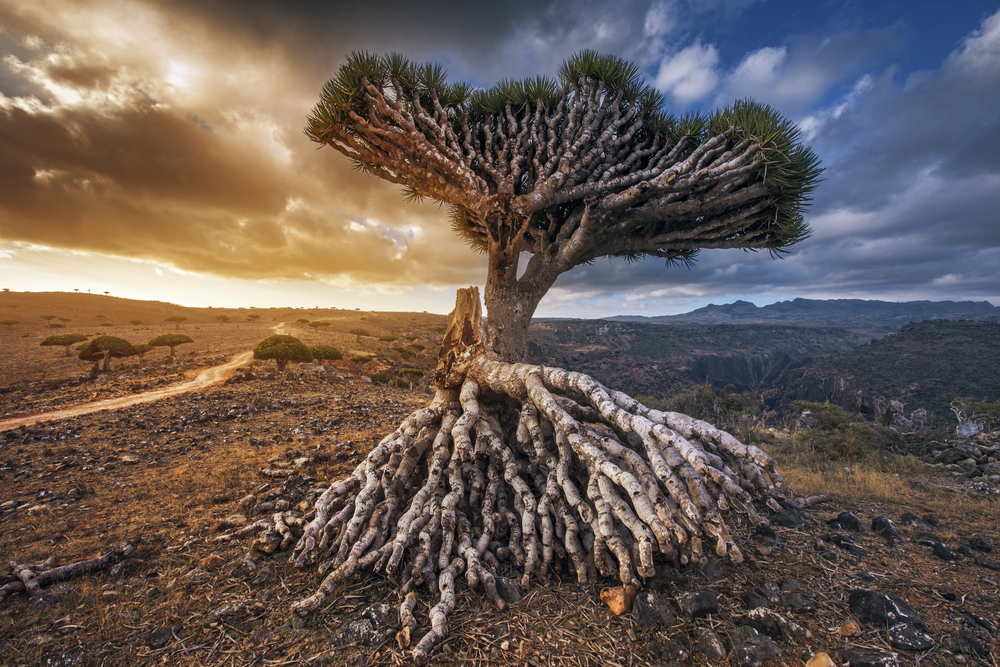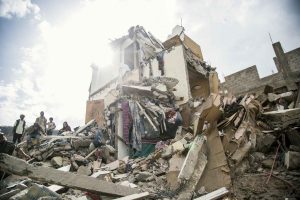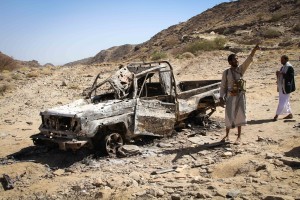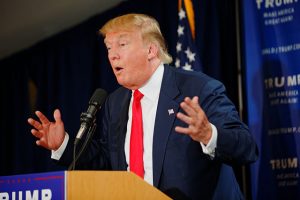by Nicolas Dunais
Listed as both a UNESCO World Heritage Site and a Man and Biosphere Reserve since 2008, the island of Socotra is considered a living laboratory by scientists and has awed the few travellers who have made it there for its stunning natural beauty. Yet it faces considerable environmental stress, being threatened by climate change, demographics, plastics and, more recently, geopolitics.
In 2015, cyclones Chapala and Megh struck the island a few weeks apart, the first time two tropical cyclones had hit Yemen in the same year. The cyclones wreaked havoc, displacing people, destroying property, and damaging nature. Iconic centuries-old dragon-blood trees were uprooted in the high plateaus. In 2018, cyclone Mekunu struck the island, causing further damage to its infrastructure and environment. Hopes for the dragon-blood trees’ regeneration were quickly dashed due to over-grazing by a 500,000 thousand strong goat population—they outnumber the island’s human population five to one—which ensured no seedlings stood a chance to develop. Climatic changes and goat encroachment have had a similar impact on the population of an endemic variety of frankincense trees, whose population has declined by 75% in recent decades.
Socotra’s relative stability has also encouraged the migration of Yemenis from the mainland. While this has undoubtedly been good for the island’s economic development, it has come at the expense of its environment. Plastic waste is now a common sight, even at what were once pristine and photogenic areas such as the Qalansiya lagoon. In parallel, rubbish collection and disposal is inadequate, as the authorities are vastly under-equipped to deal with it. In an interview with the author, Socotra’s governor, Ramzi Mahroos, said that rubbish collection trucks are too few, the rubbish incinerator is in a state of disrepair, and recycling facilities are nonexistent.
These issues aside, the armed conflict plaguing mainland Yemen has had the most insidious impact on the island’s environment. What started as a large-scale humanitarian intervention by the UAE’s Red Crescent in the wake of the 2015 cyclones was followed by the deployment of Emirati troops on Socotra in 2018 without coordination with the Yemeni government or the island’s governor. There was little rationale for the military intervention given that the Houthis—the justification for the intervention—were contained in northern Yemen, more than 1,000 kilometres away and across the Gulf of Aden. Yemen’s president vehemently protested what he called an occupation by the Emiratis.
The Emirati troops eventually departed the island (to be replaced by Saudi troops), but not before leaving behind representatives from the UAE government, from the UAE Red Crescent, and from the Abu Dhabi based Khalifa Foundation, a government sponsored charity. For governor Mahroos, these charitable organisations hide a more devious objective: buying the allegiance of Socotra’s residents, and enabling UAE traders and investors to conduct business on the island under their cover. For example, they have enabled UAE and other GCC citizens to purchase plots of Socotri land, despite a government decree banning the sale of any land on the island. Plots in protected and coastal areas have been sold for prices ranging from several hundred thousand to tens of millions of dollars, with the reported objective to develop them into private residences or tourist resorts. According to Mahroos, the UAE’s representative on the island, Khalfan al-Mazrouei, is in the process of acquiring 150,000 square meters of land on the Dixam plateau, a protected area in the center of the island.
There is no doubt that UAE charities conduct much needed development work on Socotra. Over the last several years, schools, hospitals, roads, and the island’s water distribution network have all been greatly enhanced. Inhabitants have received support to rebuild their houses, to the extent that many homes now feature an Emirati flag painted on a wall in recognition of the financing sources that made their construction possible. Socotris also benefit from free medical treatment in the UAE, to which they can travel through a private airline based in Abu Dhabi’s Al Bateen airport. While there have been concerns that the UAE intends somehow to take over the island, at least so far its interest seems to be driven by its desire to control the important maritime route through the Red Sea and the Gulf of Aden, in keeping with its desire to be a global trading power. The UAE also has incentive to keep others out—Iran’s reported involvement in Socotra in the early 2000s has undoubtedly not been forgotten, for example, and Russia and the United States have long had their eyes set on the island as a possible military base.
For Governor Mahroos and Mohammed Qubaty, Yemen’s Minister of Tourism, the political situation is making it more difficult to protect the island’s ecosystem. They are nevertheless aware of the need to strike a balance between environmental preservation on the one hand and providing economic opportunities to Socotra’s citizens on the other. The sooner Socotra’s inhabitants are weaned off the UAE aid machine, the greater the chances that the Yemeni government will be able to reestablish its sovereignty on the island and limit the risks of seeing popular allegiance shift to the UAE.
As the military situation on mainland Yemen has reached a stalemate, the next months could witness a gradual resolution to the conflict. Should the Yemeni government be able to reassert and exercise its authority on Socotra, the illegal land transactions that have occurred are likely to be rendered void. But in order to do so, the UAE’s soft power on the island would have to be reconsidered—a tall order in the absence of economic alternatives for the island’s citizens.
Nicolas Dunais is an independent advisor to GCC governments on matters of economic development and security. He has been living in the Middle East since 2004, first as an Arabic student in Yemen, then as a management consultant. Nicolas has a MSc in communication systems engineering from the Swiss Federal Institute of Technology in Lausanne, and a post-graduate certificate in international relations from the University of Leicester. He is also certified by the Handa Center for the Study of Terrorism and Political Violence, and holds a certificate of international economics from Johns Hopkins School of Advanced International Studies.





